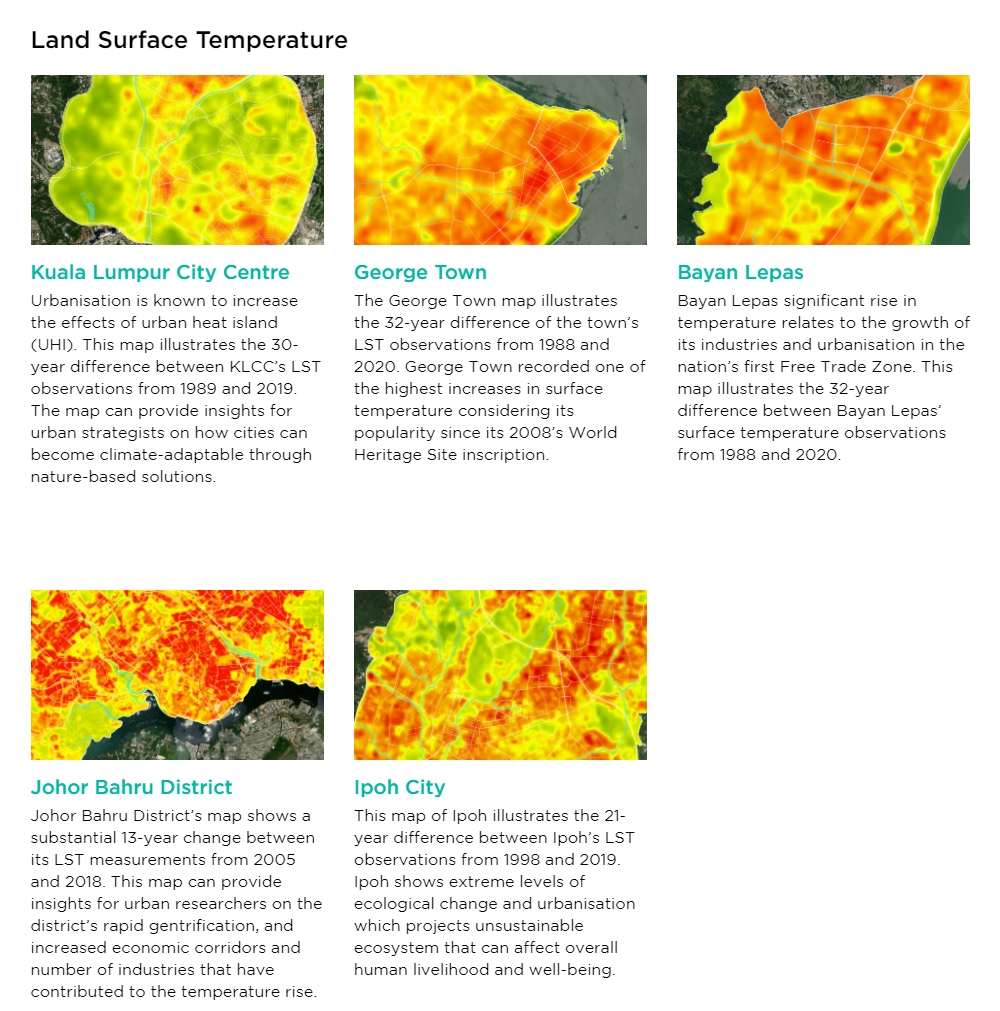Five cities in Malaysia recorded higher temperatures of between 1.64° Celsius and 6.75° Celsius over the last few decades due to development and changing urban trends, a land temperature study by Think City showed.
Interestingly, the surface temperature in Kuala Lumpur city centre had the lowest increase in temperature compared to Bayan Lepas and George Town in Penang, Ipoh in Perak and Johor Baru in Johor.

The peak temperature increase of only 1.64°C in Kuala Lumpur city centre over a 30-year period between December 1989 and October 2019 was attributed to the efficiency of domestic gardens, parks and woodlands in the city.
Not surprisingly, the hottest areas were around the city centre, Bukit Bintang, Pudu, Chow Kit and Kampung Baru while the least warm were at KL Forest Eco Park, Taman Botani Perdana and public spaces and gardens in Mahameru and KLCC.
Ipoh recorded a peak temperature increase of 6.75°C within a 21-year period between November 1998 and March 2019, the highest temperature increase among the five cities studied.
This was due to an increase in areas with a maximum temperature range — by 245 per cent in 2019 or from 66 km² to 163 km² — that indicated extreme ecological change and urban trends in Ipoh.
Johor Baru (JB) recorded a peak temperature increase of 6.70°C within a shorter period compared to the other cities, at a 13-year period between May 2005 and May 2018.
The study found that there were extensive monoculture activities detected in JB and the city’s rapid gentrification, increased economic corridors and industries contributed to significant temperature rise.
It noted that there was significant temperature rise especially in Kawasan Perindustrian Tanjung Langsat and Pasir Gudang where it rose to over 33°C in 2018.
The hottest areas in JB are Seri Purnama and Pasir Gudang which are confluences for many heavy industries such as transportation and logistics, petrochemicals, electronics, and plastics.
The study also found Skudai and Bandar Johor Baru, where many human activities and businesses are concentrated, also recorded higher temperatures.
Meanwhile, over in Penang, the industrial zone of Bayan Lepas saw a peak temperature increase of 5.63°C between February 1988 and February 2020.
The study attributed the temperature increase to the growth of industries and urbanisation in Bayan Lepas and land reclamation in south-east Penang.
“The land reclamation made way for the construction of Malaysia’s first Free Trade Zone aimed at boosting Penang’s competitive edge to grow the economy,” it said.
The hottest areas in Bayan Lepas are the industrial, commercial and residential areas.
Areas such as the Bayan Lepas Free Industrial Zones, Diamond Valley Industrial Park, Bandar Bayan Baru, Bayan Indah, Queensbay Mall and Penang International Airport recorded surface temperatures in the highest range of over 33°C.
The least warm area in the satellite city is an unoccupied and non-operational factory located in Lintang Kampung Jawa.
Over at George Town, the city saw a peak temperature increase of 6.37°C between February 1988 and February 2020.
The hottest areas that reached a maximum temperature of over 34°C were Batu Lanchang, Jelutong, Fortune Park Industry, Komtar and George Town World Heritage Site (GTWHS).
“After receiving Unesco World Heritage status in 2008, George Town gained immense traction in popularity in businesses and hospitality services which explains the high concentration of human activities leading to amplified urban heat island effects,” the study found.
According to Think City, the rise in temperature in urban areas has been linked primarily to the urban heat island (UHI) effect, the lack of greenery and global warming.
Think City Geospatial Analyst Ceelia Leong said the urban heat island effect is caused by the types of materials used in cities such as concrete and bitumen, which absorb and re-emit the sun’s heat more than natural landscapes.
“Increases in temperature, linked to climate change and urban expansion is a growing challenge for the liveability of cities, human health and urban wildlife,” she said.
She said satellite imagery was used to map the extent of the heat island effect in Malaysian cities and to observe changes over the past few decades.
She said it was evident that Malaysian cities are getting hotter due to the increased intensity of development, which is compounded by the effects of climate change.
“Secondly, the maps showed that urban greening had beneficial impact, with the ability to lower urban temperatures between two and eight degrees Celsius,” she said.
Think City Managing Director Hamdan Abdul Majeed said that the key aim of the temperature mapping was to get a snapshot of what cities were undergoing and to find solutions to battle the effects of climate change.
“At Think City, the use of analytics is extremely crucial so that we can create strategies and formulate solutions for better cities in an informed manner,” he said.
He said there is also a duty to inform the public as the battle against climate change requires a concerted effort from both the public and private sectors as well as the community-at-large.
“The democratisation of data in this manner, making it easily available through our Urban Analytics Portal is part of our climate response effort and one of the ways that we can alert and educate communities, as we identify solutions and assist communities in adapting to extreme climate events,” he said.
He said it will require all parties, from the government to the private sector to the general public, to take concerted steps to achieve sustainable development goals as this does not fall solely on the shoulders of Malaysia’s policy-makers.
“We aim to continue studies in a similar vein on a regular basis to continue monitoring the impacts of the urban heat island effect and climate change in Malaysia, and to keep finding solutions to mitigate or adapt to the harmful impacts,” he said.
Think City’s Land Surface Temperature maps can be accessed here. — Malay Mail
The post 5 Malaysian cities got hotter over the decades and KL isn’t the top of the list appeared first on SoyaCincau.com.
0 comments :
Post a Comment